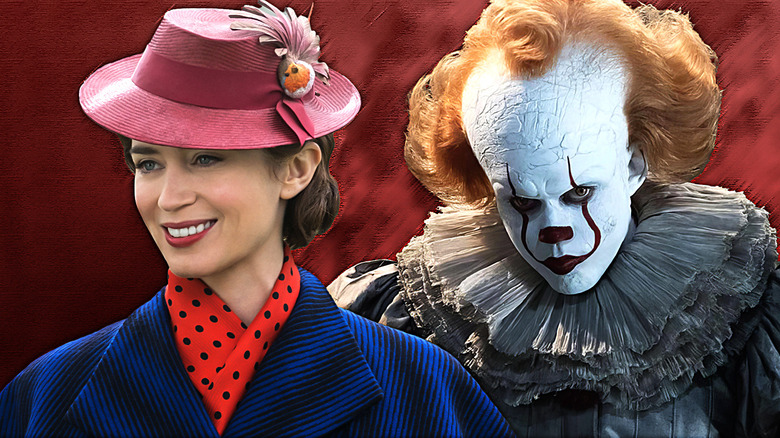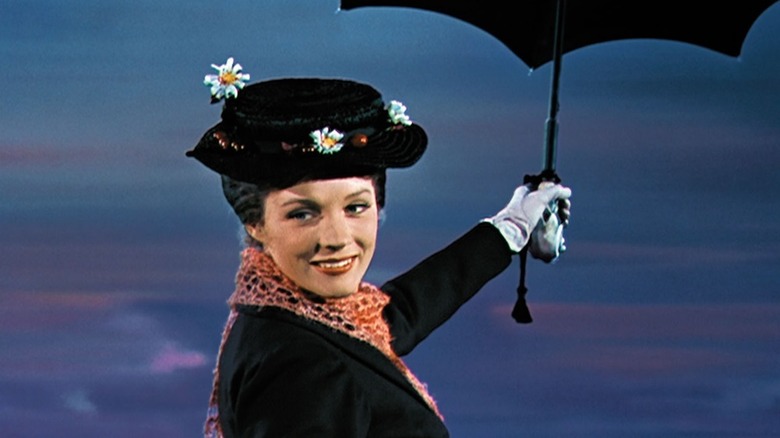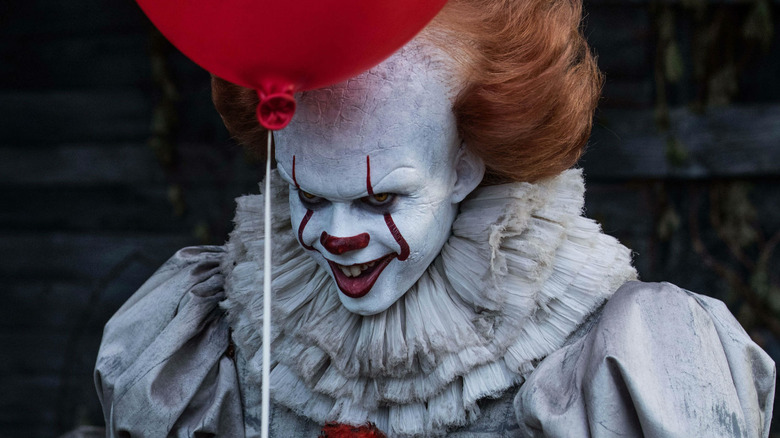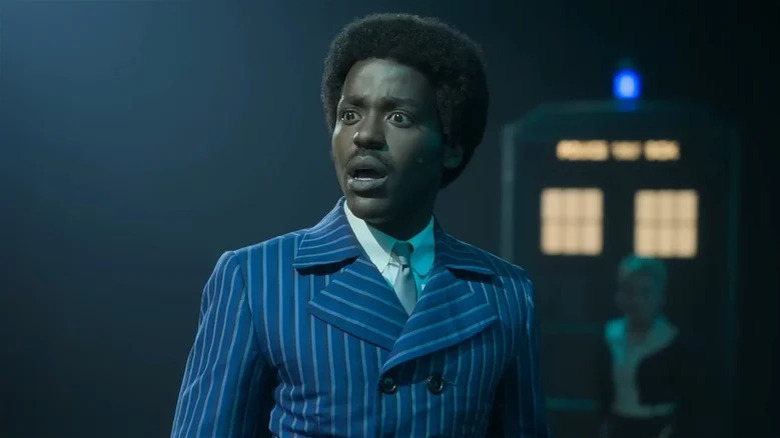Mary Poppins & Pennywise The Clown Are Related - A Horrifying Theory Explained
Mary Poppins (Julie Andrews, Emily Blunt) is a preppy flying nanny admired by Cockney chimney sweeps (with one of the worst movie accents of all time) and Marvel Cinematic Universe space pirates alike. Pennywise from "It" (Tim Curry, Bill Skarsgård) is an eldritch horror from the stars who got stuck in Derry, Maine, and seeks sustenance by inciting fear. What on Earth could the two have in common? According to one particularly weird theory that's been making the rounds on Reddit, quite a bit. In fact, it posits that the two are related as members of the same alien species.
While it's hard to imagine Mary Poppins and Pennywise sitting at the same table during Space Thanksgiving Dinner, there's a frankly odd amount of compelling evidence that they operate in a similar fashion. Pennywise emerges every 27 years to feed on children, and the plot of 2018's "Mary Poppins Returns" picks up 25 years after the 1964 original. Both target a specific group of people and are heavily associated with the element of air. Pennywise has his balloons, while Poppins prefers her flight-capable umbrella — though she's not above using balloons as well, as she demonstrates with the song "Nowhere to Go But Up."
Still, as astute viewers may have noticed, the pair do have their differences. Pennywise consumes children after scaring them into oblivion, while Mary Poppins strives to fill them with joy and wonder. However, according to the theory, this is merely because Pennywise thrives on scares, while Mary Poppins' preferred brain juice is imagination. In short, one of them operates as a monster and another as a positive, magical authority figure ... and they still get roughly the same amount of sustenance from the children, thanks to a rule established by another franchise.
The Monsters Inc. theory about the power of laughter explains why Mary Poppins is so powerful
Pennywise's dark, dark history paints the character as the ultimate boogeyman with hefty scoops of both clown and alien horror thrown in. Nevertheless, a major issue in this theory is that Mary Poppins appears to be a lot more efficient than the clown monster in what she does. Pennywise, for all his fearsome might, has to lure and terrorize quite a few children and ultimately finds dealing with the Losers' Club a major challenge. Meanwhile, Mary Poppins casually arrives and takes control. She might as well be omnipotent as far as her movies are concerned, and only needs to work with two or three children at once.
This brings us to "Monsters, Inc." As the beloved animated movie's ending establishes, a child's fear is a far less efficient energy source than their laughter, which is why the monsters pivot from their time-tested boogeyman antics to bedtime slapstick comedy. Though neither Mary Poppins nor Pennywise the Dancing Clown are part of the Pixar universe (as far as we know), this same logic might explain why the former's interactions with the children are far more benevolent than Pennywise's. She's simply learned to harness joy, imagination, and childlike wonder as a food source, while the clown entity hasn't figured out the trick — or, as the case may very well be, perhaps he simply prefers the taste of fear.
Mary Poppins and Pennywise have a similar power set
Regardless of whether you buy into the "Monsters Inc." part of the theory, there's no denying that Pennywise and Mary Poppins have surprisingly similar powers and methods. Apart from their vast reality manipulation and/or illusion powers, they both tend to command the attention of those who are at least somewhat aware of their existence and are largely forgotten by anyone who leaves their field of influence for a significant time. They can turn any scene into a fantasy display at a moment's notice. They're also highly theatrical, and fond of musical numbers.
Still, it's the small details that really sell the story. There's the aforementioned mutual fondness for balloons, for one. They also love using old-school toys to further their schemes. Pennywise uses a paper boat to lure little Georgie (Jackson Robert Scott) in "It Chapter One," while Poppins homes in on another kid with the same name (Joel Dawson) using a kite in "Mary Poppins Returns." It's also strange that both characters have extremely specific mirror-themed powers, though Poppins' mirror image has a mind of its own, while Pennywise can and does memorably manifest itself in a mirror house in "It Chapter Two."
Perhaps most chillingly, it's possible that the pair are at least somewhat aware of each other. While Mary Poppins doesn't mention monstrous murder clowns in her family-oriented movies, she seems to base her nanny operations in London. Meanwhile, Pennywise's signature song is a dark 18th Century nursery rhyme called "Oranges and Lemons," which contains some pretty gruesome lyrics and specifically describes multiple locations in, yes, London. Could this be the clown-like entity's way to communicate with a kindred spirit, or at least acknowledge a member of the same species?
And then there is the Doctor
Of course, unless both the "It" and "Mary Poppins" franchises decide to make a radical pivot and embrace this theory, all the similarities between the characters are almost certainly coincidental. Still, since theories about the character are on the table, let's stir the pot even further and look briefly at the "Doctor Who" hypothesis about Mary Poppins being a Time Lord, just like the Doctor (Ncuti Gatwa). After all, both characters are outlandish entities with mysterious powers who enter peoples' lives to help before continuing their journey. What's more, Mary Poppins' acquaintances like Jack (Lin-Manuel Miranda) and especially Bert (Dick Van Dyke) are sidekick figures who seem very similar to the Doctor's laundry list of companions.
While precisely as unlikely as the Mary Poppins-Pennywise connection, adding the "Doctor Who" theory to the mix has the fun side effect of making Pennywise a Time Lord as well. After all, he, too, is an alien with the requisite amount of whimsy, power, and penchant for theatrics. Wait, wouldn't that mean the Doctor needs to feed on children's energy as well? OK, maybe this is a good time to stop.



